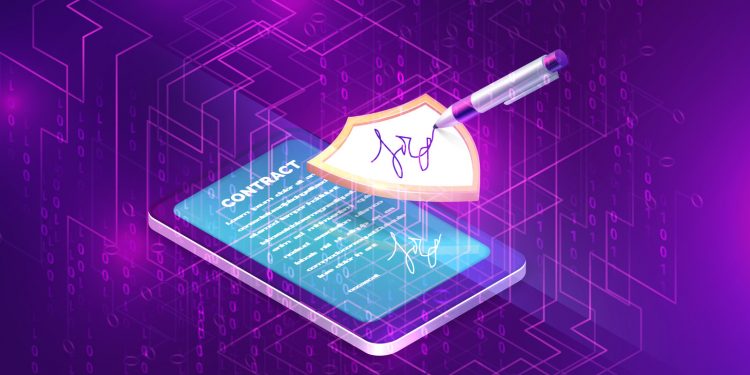In today’s fast-paced digital world, the use of electronic signatures has become increasingly prevalent in a variety of industries. As businesses strive for efficiency and convenience, the traditional pen-and-paper method of obtaining signatures has largely been replaced by the more streamlined and secure process of e-signatures. With the rise of remote work and the need for contactless transactions, the demand for electronic signature software has only continued to grow. In response, there has been a surge of innovation in this field, with new and advanced features constantly being introduced. From biometric authentication to mobile compatibility, the latest trends in electronic signature software are empowering businesses and individuals to sign documents with ease and confidence. You can easily and securely create a free sign PDF using Foxit’s eSign PDF platform. In this article, we will explore the cutting-edge developments and advancements in e-signature technology, and how they are shaping the way we handle important documents and contracts. From improved security to increased accessibility, electronic signature software is revolutionizing the way we do business and revolutionizing the definition of a signature itself.
Integration with popular business tools
As businesses increasingly rely on digital tools to streamline their operations, integration with popular business tools has become a crucial feature in electronic signature software. Seamless integration with tools such as customer relationship management (CRM) platforms, document management systems, and project management tools allows for a more efficient and streamlined workflow. By integrating e-signature software with these existing systems, businesses can eliminate manual data entry, reduce errors, and enhance productivity. This integration enables a seamless flow of information, ensuring that documents can be easily accessed, signed, and stored within the existing framework of the organization. Furthermore, integration with popular business tools enhances collaboration and communication among team members, allowing for real-time updates and notifications throughout the signing process. By empowering businesses with the ability to integrate e-signature software with their existing tools, companies can elevate their efficiency and productivity to new heights.
Enhanced security features ensure compliance
With the increasing focus on data privacy and security, enhanced security features have emerged as a key requirement in electronic signature software to ensure compliance with industry regulations and standards. Robust encryption protocols, multi-factor authentication, and audit trails are just a few of the security measures that are integrated into modern electronic signature solutions. These features provide businesses with the peace of mind that their sensitive documents and data are protected throughout the signing process. In addition, advanced authentication methods, such as biometric verification, add an extra layer of security, further reducing the risk of unauthorized access or tampering. By implementing these enhanced security features, businesses can confidently leverage electronic signatures while maintaining compliance with applicable legal and regulatory frameworks.
User-friendly interface for seamless experience
In addition to robust security measures, another key trend in electronic signature software is the emphasis on a user-friendly interface for a seamless experience. Recognizing the importance of simplicity and ease of use, developers are prioritizing intuitive design and navigation to ensure that users can effortlessly navigate the software and complete the signing process with minimal effort. Clear and concise instructions, drag-and-drop functionality, and customizable templates are just a few features that contribute to a user-friendly interface. By streamlining the signing process and eliminating any unnecessary complexities, businesses can enhance productivity and efficiency while ensuring a positive user experience. Whether signing a document on a desktop computer or a mobile device, a user-friendly interface allows individuals to confidently adopt and utilize electronic signature software, ultimately driving widespread adoption across industries.
Mobile accessibility for on-the-go transactions
In today’s fast-paced world, mobile accessibility has become a key factor in empowering on-the-go transactions through electronic signature software. With the increasing reliance on smartphones and tablets for business operations, it is essential for electronic signature software to offer seamless mobile functionality. This enables individuals to conveniently sign documents anytime, anywhere, without being tied to a desktop computer. Mobile accessibility not only enhances flexibility and convenience but also enables businesses to expedite the signing process, reducing delays and improving overall efficiency. Users can securely sign documents, review contracts, and complete transactions with ease, providing a seamless and efficient experience while maintaining the highest level of security. As mobile devices continue to dominate the digital landscape, incorporating mobile accessibility into electronic signature software is crucial for businesses to stay competitive and cater to the needs of their on-the-go clientele.
Advanced customization options for branding
One of the key trends in electronic signature software is the availability of advanced customization options for branding. Businesses understand the importance of maintaining a consistent brand identity throughout all their communication channels, and electronic signature software is no exception. With advanced customization options, businesses can now incorporate their logos, colors, and brand elements into the electronic signature process, creating a cohesive and professional appearance. This level of branding customization not only enhances the overall user experience but also reinforces the trust and credibility of the company. Additionally, businesses can customize email templates, adding personalized messages and additional branding elements to create a unique and memorable interaction with clients and partners. By leveraging advanced customization options for branding, businesses can establish a strong and recognizable presence within the electronic signature process, further solidifying their professional image.
Conclusion
Electronic signature software has become an essential tool for businesses in today’s digital age. With advancements in technology and increasing demand for remote and paperless transactions, e-signatures have evolved to offer a more streamlined and secure process. From biometric authentication to integration with other business applications, the latest trends in electronic signature software are empowering organizations to improve efficiency, reduce costs, and enhance the overall customer experience. As we move towards a more digital future, it’s clear that e-signatures will continue to play a crucial role in simplifying and modernizing the way we do business.















